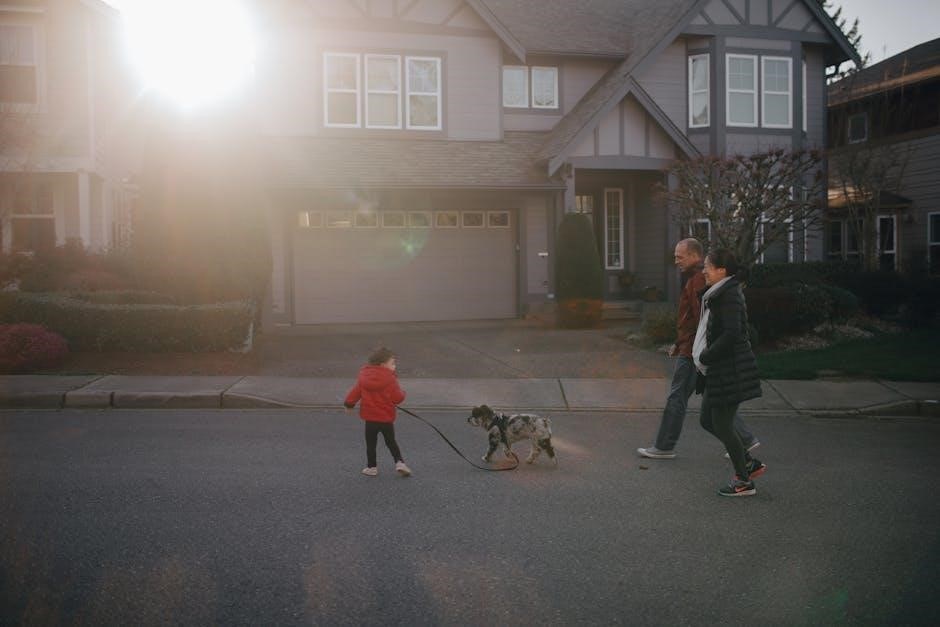
Welcome to the Walking Dead Parents Guide, your essential resource for understanding the series’ mature themes, violence, and strong language, helping you make informed viewing decisions for your family.
1.1 Overview of the Series and Its Mature Themes
The Walking Dead is a post-apocalyptic horror drama that explores survival, morality, and human nature amidst a zombie-infested world. The series delves into mature themes such as intense violence, graphic gore, and strong language, making it unsuitable for younger audiences. It also addresses complex ethical dilemmas, emotional trauma, and the breakdown of societal norms. While the show offers compelling storytelling and character development, its mature content necessitates careful consideration by parents. This guide aims to provide a detailed analysis of these elements to help families make informed decisions about viewing the series.
1.2 Importance of Parental Guidance for Mature Content
Parental guidance is crucial when considering The Walking Dead due to its mature content, including graphic violence, strong language, and intense emotional themes. The series often features scenes that may disturb younger viewers, such as frequent gore and unsettling imagery. Parents should evaluate their child’s sensitivity and maturity before allowing them to watch. Co-viewing with teenagers can provide opportunities for open discussions about the show’s themes, helping them process the content responsibly. Understanding the series’ nature ensures parents can make informed decisions about their child’s exposure to its potentially unsettling elements.

Age Rating and Maturity Level
The Walking Dead carries a TV-MA rating, indicating its content is designed for mature audiences, particularly those aged 17 and older, due to its intense themes and violence.
2.1 TV-MA Rating Explained
The TV-MA rating assigned to The Walking Dead signifies that the content is explicitly intended for mature audiences only. This designation by the TV Parental Guidelines is reserved for programming that contains material deemed unsuitable for viewers under the age of 17. Such content may include graphic violence, strong language, sexual situations, or other mature themes that could be inappropriate for younger audiences. The TV-MA rating serves as a clear indicator to parents and guardians that the series is not suitable for children, emphasizing the need for discretion and oversight when deciding whether to allow teenage viewers to watch the show.
2.2 Reasons Behind the Mature Audience Rating
The Walking Dead earns its TV-MA rating primarily due to its intense and graphic content. The series frequently depicts violent scenes, including brutal killings, gore, and unsettling zombie imagery, which are central to its post-apocalyptic narrative. Additionally, the show incorporates strong language and occasional sexual content, further contributing to its mature classification. Themes of survival and moral dilemmas, while thought-provoking, also involve complex and often disturbing scenarios that may not be appropriate for younger viewers. These elements collectively justify the TV-MA rating, ensuring that parents are aware of the content’s nature and can make informed decisions about their children’s viewing habits.

Violence and Gore in The Walking Dead
The Walking Dead features frequent and intense violence, including graphic gore like impalings, blood spatters, and unsettling zombie imagery. These scenes are central to the narrative, often depicting brutal survival scenarios that may disturb young or sensitive viewers. The violence is both physical and emotional, emphasizing the harsh realities of a post-apocalyptic world and the moral compromises characters must make. While the gore can be extreme, it serves to underscore the show’s dark themes and the constant threat of death, making it unsuitable for younger audiences.
3.1 Frequency and Intensity of Violent Scenes
The Walking Dead frequently depicts violent scenes, with a high intensity that often includes graphic gore. The series showcases brutal fights, zombie attacks, and character deaths, many of which are disturbing and prolonged. Violence is a central element, with episodes regularly featuring impalings, stabbings, and shootings. The gore is severe, with explicit imagery of blood, wounds, and mutilated bodies. These scenes are not only frequent but also emotionally impactful, as they often involve key characters. The show’s post-apocalyptic setting amplifies the brutality, making it a key aspect of the narrative. Parents should be aware that the violence is not gratuitous but is integral to the story, yet it remains unsuitable for younger or sensitive viewers due to its graphic nature and emotional weight.
3;2 Graphic Imagery and Gore
The Walking Dead is renowned for its graphic imagery and gore, which are central to its storytelling. The series frequently features detailed depictions of wounds, mutilations, and zombie dismemberment, often with explicit close-ups. Scenes of characters being bitten, stabbed, or shot are common, with blood splatter and severed body parts shown prominently. The gore is not only visual but also emotional, as it often involves key characters and pivotal moments. This level of graphic content is intended to emphasize the harsh reality of the post-apocalyptic world. While it serves the narrative, it is crucial for parents to recognize that such imagery can be deeply unsettling and is unsuitable for younger audiences. The show’s commitment to realism in its gore makes it a significant concern for family viewing.
3.3 Emotional Impact of Violent Content on Young Viewers
The Walking Dead’s violent content can have a profound emotional impact on young viewers, potentially leading to increased anxiety, fear, and desensitization to violence. The graphic scenes, including zombie attacks and human conflict, often create a sense of tension and dread. Young audiences may struggle to differentiate between the fictional world and reality, causing long-term emotional distress. The show’s intense moments, such as character deaths and moral dilemmas, can also evoke strong emotions like sadness and anger. Parents should be aware of these potential effects and consider whether their child is emotionally prepared to handle such mature themes. Open conversations about the content can help mitigate negative impacts and foster a healthier understanding of the series’ context.

Sexual Content and Nudity
The Walking Dead features mild sexual content and brief nudity, with scenes typically implied rather than explicit, ensuring they align with its TV-MA rating for mature audiences only.
4.1 Mild Sexual Content in the Series
The series includes mild sexual content, often hinted at through dialogue or brief scenes, rather than explicit portrayals. Relationships and intimacy are occasionally shown, but these moments are not graphic. For instance, characters may be depicted in bed together, with limited nudity, focusing more on emotional connection than explicit details. These scenes are sparse and woven into the narrative to develop character dynamics. Parents should note that while such content is not pervasive, it may still warrant discretion for younger audiences. The show’s focus remains on survival and drama, with sexual content serving a secondary role in storytelling.
4.2 Brief Nudity and Suggestive Scenes
The series occasionally features brief nudity and suggestive scenes, though these moments are not explicit or prolonged. Nudity is typically limited to partial exposure, such as shoulders or upper chests, and is rarely central to the storyline. Suggestive dialogue or implied intimacy may occur, but these instances are infrequent and not graphically depicted. For example, characters might be shown in bed together, but without explicit content. While these scenes are mild compared to other mature themes, parents should be aware of their presence and use discretion when allowing younger viewers to watch. The focus of the show remains on survival and drama, with such content serving to enhance character development rather than distract from the narrative.

Profanity and Strong Language
The Walking Dead frequently includes strong language, such as profanity and expletives, to reflect the intense emotions and high-stakes situations faced by characters in a dire world.
5.1 Use of Strong Language in the Show
The Walking Dead incorporates strong language to emphasize the dire nature of its post-apocalyptic setting. Characters often use expletives like “shit” or “fuck” during intense or emotional moments, reflecting real-world reactions to high-stress situations. This language adds authenticity to the characters’ struggles and interactions. However, it also contributes to the show’s TV-MA rating, making it unsuitable for younger audiences. Parents should be aware that such language is frequent and may not align with all household standards. The use of strong language serves narrative purposes but is a key factor in determining the show’s maturity level and viewer appropriateness.
5.2 Examples of Profanity and Its Context
The Walking Dead features occasional yet impactful use of profanity, often in high-tension scenarios. Characters might utter expletives like “shit” or “fuck” during intense confrontations or emotional breakdowns. For instance, when faced with immediate danger, a character might exclaim, “Oh shit!” to express fear or urgency. Similarly, in moments of frustration or anger, dialogue may include phrases like “This is fucked up!” to convey desperation. These examples highlight how profanity is used to reflect real-world reactions to the show’s dire situations, adding emotional depth and authenticity to the narrative. Parents should remain cautious, as such language may not align with all family values, despite its contextual relevance.

Alcohol, Drugs, and Smoking
The series occasionally depicts alcohol and drug use, often in survival contexts or character development. Smoking is rarely shown, but substance use is present, impacting young viewers.
6.1 Depiction of Substance Use in the Series
The Walking Dead occasionally portrays alcohol and drug use, often in survival contexts. Characters may consume alcohol to cope with stress or find solace in a dire world. Drug use is less frequent but appears in specific storylines, such as medicinal use or character backstories. These depictions are typically not glorified but serve narrative purposes, highlighting the harsh realities of a post-apocalyptic environment. Smoking is rarely shown and not emphasized as a significant theme. Overall, substance use is handled maturely, reflecting the characters’ struggles without promoting misuse. This aspect requires parental awareness, especially for younger audiences, to contextualize its portrayal within the story’s framework.
6.2 Impact of These Themes on Young Audiences
The depiction of substance use in The Walking Dead can have varying effects on young viewers. While the show often portrays alcohol and drugs in a survivalist context or as coping mechanisms, impressionable audiences may misinterpret these scenes. Parents should be cautious, as repeated exposure to such themes could normalize substance use. Younger viewers might not fully grasp the consequences of drug and alcohol consumption, potentially leading to curiosity or experimentation. It is crucial for parents to monitor and discuss these scenes, emphasizing the risks and inappropriate nature of substance use. Open conversations can help young audiences understand the differences between fictional portrayals and real-life implications, fostering a critical perspective on these mature themes.

Frightening and Intense Scenes
The Walking Dead features a suspenseful atmosphere, jump scares, and graphic zombie imagery, creating a frightening experience that may deeply unsettle younger or sensitive viewers.
7.1 Suspenseful Atmosphere and Jump Scares
The Walking Dead masterfully crafts a suspenseful atmosphere, keeping viewers on edge with eerie settings and sudden jump scares. The show often builds tension through silence, shadows, and the unpredictable movements of walkers, creating a sense of dread. Jump scares are frequent, often involving unexpected appearances of zombies or violent confrontations. These intense moments are heightened by the show’s sound design and visuals, making them particularly unsettling for younger or more sensitive audiences. Parents should be cautious, as these scenes can evoke strong emotional reactions and may not be suitable for all viewers, especially children prone to fear or anxiety.
7.2 Graphic Zombie Imagery and Gore
The Walking Dead features graphic zombie imagery and gore, which are central to its post-apocalyptic horror theme. Scenes often depict walkers feasting on flesh, with explicit visuals of dismemberment, blood splatter, and decaying bodies. The show does not shy away from detailed close-ups of injuries, bites, and mutilations, creating a visceral viewing experience. Parents should be aware that these graphic elements can be deeply disturbing for young or sensitive viewers. The frequent and intense nature of such content makes it essential for parents to assess their child’s maturity level before allowing them to watch, as it may lead to nightmares or a desensitization to violence.

Positive Messages and Themes
The Walking Dead explores themes of survival, hope, and resilience, offering depth and moral dilemmas that inspire reflection, even amidst its grim post-apocalyptic setting.
8.1 Themes of Survival, Hope, and Resilience
The Walking Dead underscores themes of survival, hope, and resilience, showcasing how characters adapt and persevere in a harsh, post-apocalyptic world. The series highlights the importance of human connection, cooperation, and sacrifice, emphasizing that even in the darkest times, there is always a glimmer of hope; These themes inspire resilience, encouraging viewers to reflect on their own strength and ability to overcome adversity. By portraying characters who find purpose and meaning amidst chaos, the show delivers a powerful message about the human spirit’s capacity to endure and rebuild. These positive elements provide a balance to the series’ darker content, offering audiences a deeper, more meaningful narrative experience.
8.2 Morality and Ethical Dilemmas in a Post-Apocalyptic World
The Walking Dead explores complex moral and ethical dilemmas, challenging characters to confront difficult choices in a world without formal law or social order. The series delves into themes of right versus wrong, often blurring the lines between the two. Characters must decide whether to prioritize survival, protect others, or uphold their personal values, frequently leading to emotionally charged conflicts. These moral struggles highlight the tension between humanity and the harsh realities of their environment. The show also examines the consequences of these decisions, showcasing how they shape the characters’ identities and relationships. By addressing these ethical questions, The Walking Dead encourages viewers to reflect on their own moral compass and the principles they would uphold in extreme circumstances. This depth adds layers to the narrative, making it more than just a horror series.

Parental Discretion and Viewing Guidelines
Parental discretion is crucial due to the show’s mature themes, violence, and strong language. The TV-MA rating suggests the series is intended for viewers 17 and older. Parents are encouraged to watch with teenagers to facilitate open conversations about the content and its implications. This collaborative viewing approach helps young audiences process the intense scenes and complex moral dilemmas presented in The Walking Dead.
9.1 Recommended Age for Watching the Show
The Walking Dead Parents Guide strongly recommends that the series is only suitable for viewers aged 17 and above due to its TV-MA rating. This rating signifies that the content includes mature themes, graphic violence, strong language, and intense scenes that may not be appropriate for younger audiences. Parents should exercise caution and consider their child’s sensitivity and maturity level before allowing them to watch. The show’s intense nature, including frequent gore and emotional distress, makes it unsuitable for children under 17. Guidance from parents or guardians is essential to help young viewers understand and process the complex and often unsettling content presented in the series.
9.2 Tips for Co-Viewing with Teenagers
Co-viewing The Walking Dead with teenagers can be a valuable way to guide their understanding of the show’s complex themes. Start by discussing the mature content beforehand to prepare them for what they’ll see. Watching together allows you to pause and address any questions or concerns they may have. Encourage open conversations about the show’s violence, morality, and emotional impact. This can help teenagers critically think about the differences between fiction and real-life values. Setting boundaries, such as limiting the number of episodes watched in one sitting, can also help manage exposure. Use this opportunity to reinforce positive messages and discuss the consequences of the characters’ actions. Co-viewing fosters a safer environment for young viewers to engage with the series.
Comparisons with Other Walking Dead Spin-offs
The Walking Dead spin-offs like Fear the Walking Dead and The Walking Dead: Dead City offer unique takes on the zombie apocalypse, with varying tones and character-focused storytelling.
10.1 Similarities and Differences in Mature Content
While Fear the Walking Dead and The Walking Dead: Dead City share the same post-apocalyptic universe, their mature content varies in intensity. Fear the Walking Dead often focuses on emotional drama and moral dilemmas, with occasional graphic violence. In contrast, Dead City amplifies the horror elements, featuring more intense action and suspense. Both series include strong language and some sexual content, but Dead City leans more into dark themes and unsettling imagery. Other spin-offs, like Daryl Dixon, emphasize survival and character-driven stories, with less overt gore. Overall, while the core themes of violence and survival remain consistent, each spin-off tailors its approach to mature content, offering distinct viewing experiences for audiences.
10.2 How Spin-offs Like Fear the Walking Dead Compare
Fear the Walking Dead serves as a prequel to the original series, exploring the early days of the zombie apocalypse in Los Angeles. While it shares the same universe and mature themes, its tone and focus differ. The spin-off emphasizes character-driven stories and emotional struggles, often delving into family dynamics and moral choices. Violence and gore are present but slightly less intense compared to the main series. Fear the Walking Dead also introduces new settings and conflicts, offering a fresh perspective on survival. However, it retains the franchise’s signature suspense and intense scenes, making it similarly unsuitable for young audiences. Parents should remain cautious due to its mature content, despite the shifted narrative approach.

Cultural and Social Impact of The Walking Dead
The Walking Dead has significantly influenced pop culture, sparking discussions about survival ethics and human nature in crises. Its mature themes have fueled debates among audiences worldwide.
11.1 How the Show Influences Pop Culture
The Walking Dead has profoundly impacted pop culture, inspiring countless memes, fan art, and cosplay. Its iconic characters, like Daryl Dixon, have become household names, while its themes of survival resonate globally. The show’s influence extends to music, with soundtracks featuring prominent artists, and its merchandise dominates retail markets. Fan communities thrive online, discussing theories and creating content. The series’ success has also spawned spin-offs, proving its lasting appeal. Its ability to blend horror with deep emotional storytelling has set a new standard for television, making it a cultural phenomenon that continues to captivate audiences worldwide.
11.2 Discussions About the Show’s Mature Themes
The Walking Dead sparks intense discussions about its mature themes, including graphic violence, moral dilemmas, and survival ethics. Parents and critics debate the show’s suitability for younger audiences due to its intense gore and strong language. The series’ exploration of humanity in a post-apocalyptic world raises questions about morality, sacrifice, and leadership. These themes resonate deeply, encouraging viewers to reflect on their own values. While some praise the show’s depth, others highlight concerns about its impact on sensitive or impressionable viewers. The ongoing conversations underscore the importance of parental guidance and open dialogue about the show’s content and its implications for young audiences.
The Walking Dead Parents Guide emphasizes the importance of parental guidance due to the show’s mature themes, violence, and strong language, helping families make informed viewing decisions.
12.1 Final Thoughts for Parents
The Walking Dead is a gripping series with mature themes, graphic violence, and strong language, making it essential for parents to exercise caution. The show’s intense content, including frequent gore and emotional distress, may not be suitable for younger or sensitive viewers. Parents should carefully review episodes and consider their child’s maturity before allowing them to watch. Open conversations about the show’s themes can help children process its complex moral dilemmas and violent scenes. Co-viewing is recommended to guide discussions and ensure the content aligns with your family’s values. Ultimately, parental discretion is crucial to navigating The Walking Dead’s mature storytelling.
12.2 Encouraging Open Conversations with Children
Encouraging open conversations with children about The Walking Dead is vital for helping them process its mature themes. Parents should ask questions, listen actively, and guide discussions about violence, morality, and survival ethics. This fosters critical thinking and emotional resilience. Discussing the show’s fictional nature versus real-life values clarifies boundaries. Encourage kids to express feelings about intense scenes and explore how characters’ choices reflect broader life lessons. Open dialogue helps children differentiate between entertainment and reality, ensuring they understand the series’ complex narratives responsibly. By engaging in these conversations, parents can turn a potentially unsettling experience into a meaningful learning opportunity, fostering trust and understanding.